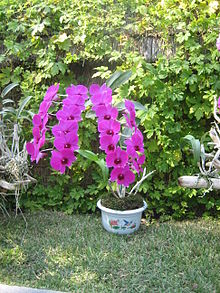
Summary
Kimilsungia is a hybrid orchid cultivar of the genus Dendrobium. It is a clone of a plant that was created in Indonesia by orchid breeder Carl Ludwig C. L. Bundt, who in 1964 registered the grex name Dendrobium Clara Bundt for all orchids of the same ancestry, naming it after his daughter. It has a complex ancestry from cultivated orchids. An attempt was made to register the grex name Dendrobium Kimilsungia, but this is not valid, it is a later synonym of Dendrobium Clara Bundt. As a cultivar name (applying to only part of the grex), the correct name is Dendrobium Clara Bundt 'Kimilsungia'. Another grex name Dendrobium Kimilsung Flower refers to plants of related but different ancestry.[1]
| 'Kimilsungia' | |
|---|---|
 | |
| Genus | Dendrobium |
| Cultivar | Dendrobium Clara Bundt gx 'Kimilsungia' |
| Kimilsungia | |
| Chosŏn'gŭl | 김일성화 |
|---|---|
| Hancha | 金日成花 |
| Revised Romanization | Gimilseonghwa |
| McCune–Reischauer | Kimilsŏnghwa |
Another flower, the Kimjongilia, is named after Kim Il Sung's son, Kim Jong Il. Neither the Kimilsungia nor the Kimjongilia are the national flower of North Korea. The national flower of the country is the Magnolia sieboldii with white flowers.[2]
According to the Korean Central News Agency, Kim Il Sung's "peerless character" is "fully reflected in the immortal flower" which is "blooming everywhere on the five continents".[3]
Description edit
The plant grows 30 to 70 centimetres (12–28 in) high. Its leaves adhere to the nodes alternatively and each stalk yields 3-15 flowers. The flowers have three petals and three calyxes and measure 6 to 8 centimetres (2.4–3.1 in). It blooms for 60–90 days. It grows best in daylight temperatures of 25 to 30 °C (77 to 86 °F) and 18 to 23 °C (64 to 73 °F) at night.[4]
History edit
During President Kim Il Sung's visit to Indonesia in 1965, Presidents Sukarno and Kim were touring the Bogor Botanical Gardens when the latter was smitten by an orchid originating from Makassar[citation needed], which had been cultivated to bloom during his visit. President Sukarno, seeing Kim's enthusiasm, proposed that the flower be named Kimilsungia, as a symbol of eternal friendship between the two countries. Reportedly, Kim Il Sung initially declined the offer, but upon Sukarno's insistence he had to accept.[5][6]
In North Korea, the flower was successfully cultivated in April 1975, in time for Kim Il Sung's birthday, and subsequently introduced to the North Korean populace for the first time in April 1977, for Kim Il Sung's 65th birthday. The violet Kimilsungia orchid has since become a symbol of the late Juche leader, being used in floral arrangements representing the North Korean state.[7]
Annual festivals edit
The annual Kimilsungia Festival has been held since 1998,[8] and is held around the Day of the Sun.[9] Kimilsungia flower shows are held every year in Pyongyang. Traditionally, embassies of foreign countries in North Korea each present their own bouquet of the flower to the annual exhibition.[10]
See also edit
References edit
- ^ Soediono, Noes; Arditti, Joseph; Soediono, Rubismo (2011). "Kimilsungia: How an Indonesian Orchid Became a Revered Symbol in the Democratic People's Republic of Korea After Its Name was Changed" (PDF). Plant Science Bulletin. 57 (3). Botanical Society of America: 103–113.
- ^ Korea Today. No. 627. September 2008. cover inset. ISSN 0454-4072.
- ^ "4th Kimilsungia Show to be held in Pyongyang". Korean Central News Agency. March 21, 2002. Archived from the original on June 7, 2015. Retrieved December 19, 2009.
- ^ Hwan Ju, Pang (1998). "Kimilsungia". Kimjongilia. Pyongyang, North Korea: Foreign Languages Publishing House. p. 8.
- ^ "Kimilsungia Flower". Koryo Tours. Koryo Tours. Retrieved November 4, 2023.
- ^ Juniartha, Yobely. "Kim Il Sung, Pendiri Korea Utara yang Berteman Baik dengan Sukarno". zenius.net. Zenius. Retrieved November 4, 2023.
- ^ "Patriotic Flora of North Korea: Kimilsungia and Kimjongilia". worldhistory.us. Retrieved November 4, 2023.
- ^ Pang Un-ju (April 6, 2017). "Preparations for flower festival in full swing". The Pyongyang Times. Retrieved May 16, 2017.
- ^ Ralph C. Hassig; Kong Dan Oh (2009). The Hidden People of North Korea: Everyday Life in the Hermit Kingdom. Rowman & Littlefield. p. 298. ISBN 978-0-7425-6718-4. Retrieved May 3, 2015 – via Internet Archive.
- ^ Ford, Glyn; Kwon, Soyoung (2008). North Korea on the brink: struggle for survival. Pluto Press. p. 98. ISBN 978-0-7453-2598-9.
Further reading edit
- Kim In Gi; Pang Hwan Ju (1999). Kimilsungia – Aroma of Flower Symbolic of a Great Man is Everlasting (PDF). Translated by Choe Ki Ju, An Jong Ho. Pyongyang: Foreign Languages Publishing House. OCLC 759588680.
- Pak Chun Hwa; Kim In Il, eds. (2007). Kimilsungia (PDF). Plant in Full Bloom. Vol. 1. Translated by Kim Kun Hui. National Institute for Standardization. OCLC 837310890.
- O Hae Yon (2015). Kimilsungia, Flower Dedicated to a Great Man. Pyongyang: Foreign Languages Publishing House. ISBN 978-9946-0-1254-4.
- Ri Wan Jun; et al. (2011). Thak Song Il; et al. (eds.). Encyclopedia of Kimilsungia (PDF). Translated by An Jong Ho et al. Pyongyang: Foreign Languages Publishing House. ISBN 978-9946-0-0665-9.
External links edit
- "Kimilsungia Is an Immortal Flower That has Bloomed in the Hearts of Mankind in the Era of Independence" – Kim Jong Il on Kimilsungia, April 6, 2005.


